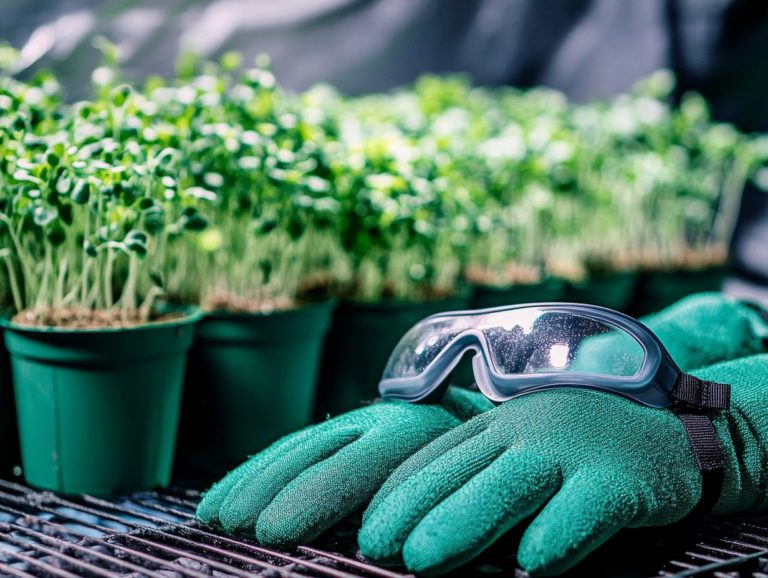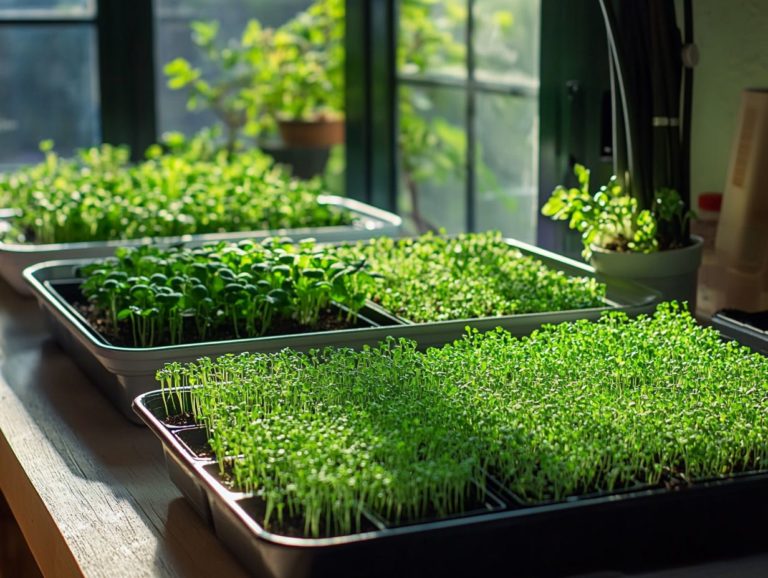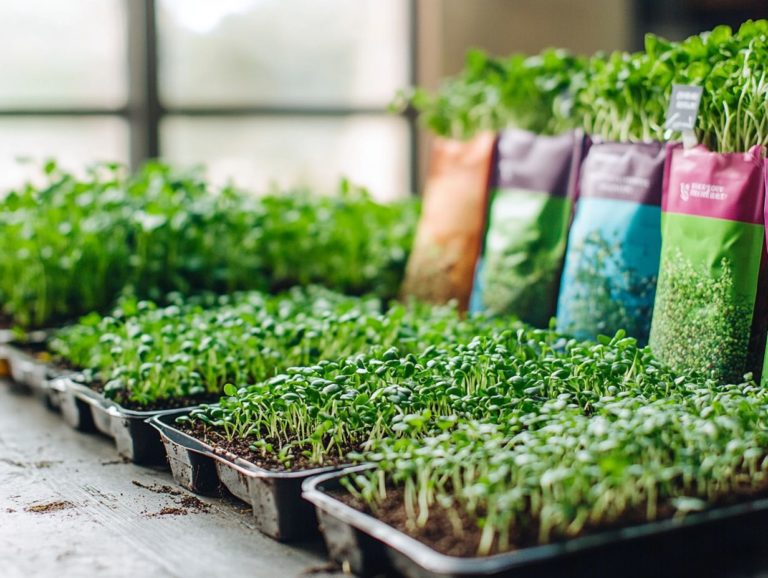Top 5 Mistakes in Microgreen Equipment Choices
Microgreens offer a wonderful opportunity to elevate the freshness and nutrition of your meals. Successfully nurturing them requires a keen grasp of the finer details.
Many aspiring microgreen gardeners face challenges early on, often due to common missteps in equipment selection, seed choice, and market research.
You ll want to steer clear of the top five pitfalls. These include choosing the wrong growing medium and overlooking essential lighting and ventilation.
You’ll receive expert tips to ensure your microgreen journey is not only fruitful but also enjoyable, promoting healthy living.
Get ready to unlock your green thumb today! Let s dive in!
Contents
- Key Takeaways:
- 1. Choosing the Wrong Type of Growing Medium
- 2. Not Considering the Size and Space of the Growing Area
- 3. Neglecting Proper Lighting and Temperature Control
- 4. Not Investing in Quality Seeds and Nutrients
- 5. Underestimating the Importance of Proper Ventilation
- What Are Microgreens and Why Are They Popular?
- What Are the Different Types of Growing Mediums for Microgreens?
- How Can the Size and Space of the Growing Area Affect Microgreen Production?
- What Are the Optimal Lighting and Temperature Conditions for Microgreens?
- Why Is It Important to Use Quality Seeds and Nutrients for Microgreens?
- How Does Proper Ventilation Affect Microgreen Growth and Quality?
- What Are the Common Mistakes Made in Microgreen Equipment Choices?
- How Can These Mistakes Be Avoided or Corrected?
- What Are the Benefits of Investing in the Right Microgreen Equipment?
- What are some additional tips for successful microgreen production?
- What are the potential risks of not using the appropriate equipment for microgreens?
- Frequently Asked Questions
- What are the top 5 mistakes to avoid when choosing equipment for microgreens?
- How does the size and type of grow space affect equipment choices for microgreens?
- Why is it important to choose equipment suitable for the specific type of microgreens?
- What should be taken into consideration when it comes to the cost and maintenance of equipment for growing microgreens?
- Why is it important to research and compare different brands and models of equipment for healthy living with microgreens?
- How does proper ventilation and lighting play a role in choosing equipment for indoor gardening with microgreens?
Key Takeaways:
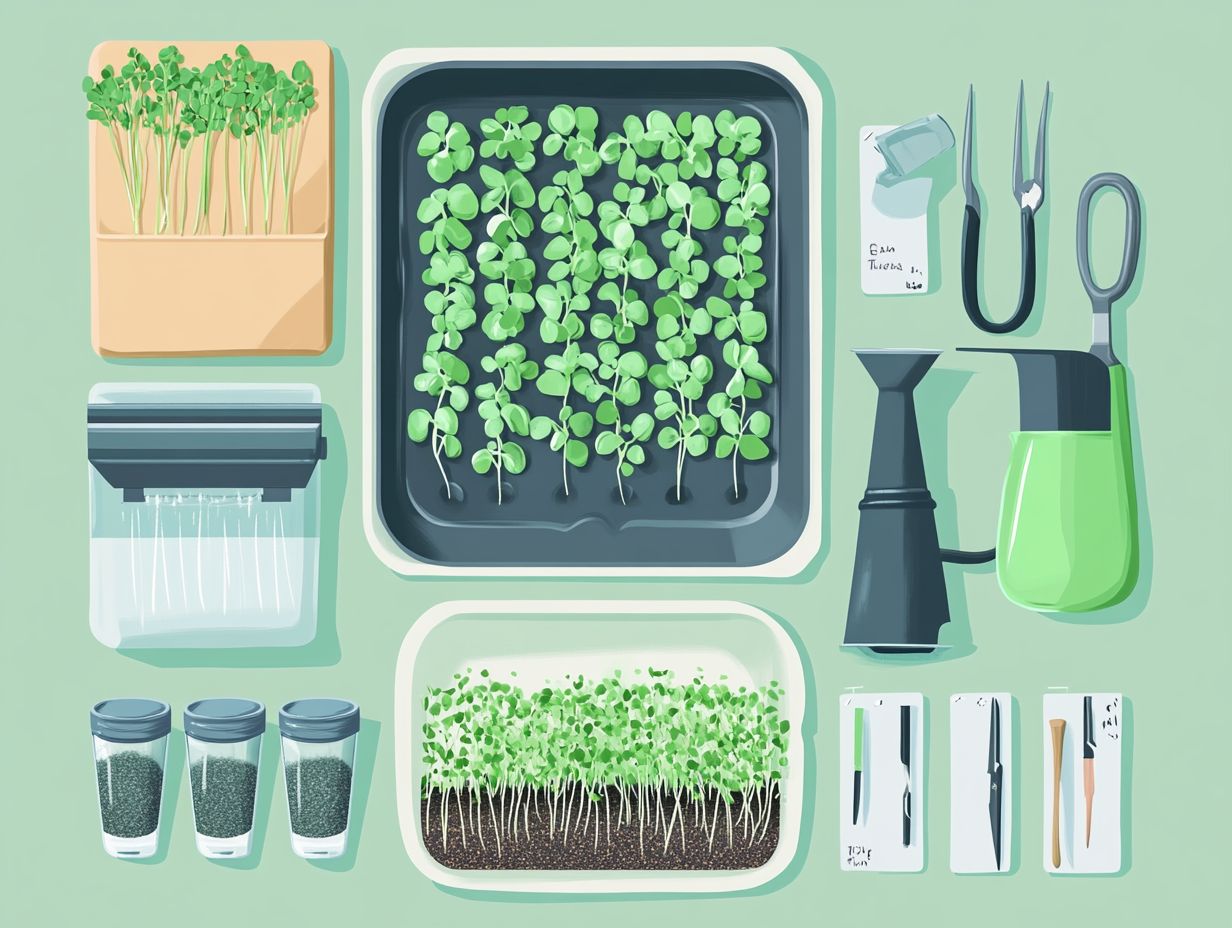
- Choosing the right growing medium is crucial for successful microgreen production.
- Consider the size and space of your growing area to optimize microgreen growth and yield, helping to avoid challenges associated with uneven growth.
- Proper lighting, temperature control, and ventilation are essential for healthy and flavorful microgreens.
1. Choosing the Wrong Type of Growing Medium
Selecting the right growing medium is vital for your microgreens, as it directly affects germination rates and nutritional value.
Many novice growers mistakenly pick inappropriate mediums, leading to uneven growth and issues like yellowing microgreens that can derail your healthy living goals.
Explore different options, like Coco Mats and Coco Coir, to find the best fit for your microgreens.
Additionally, popular choices like peat moss, vermiculite, and seedling mix offer unique benefits that can support robust development. Experts, including Connor Hiebel, stress the importance of maintaining the right moisture levels and ensuring your chosen medium retains enough nutrients without compacting too tightly, which can hinder root growth.
He also advises against using garden soil, which may introduce pests and diseases that could negatively impact your delicate microgreens. By prioritizing quality soil and understanding the specific needs of your crop, you can cultivate a thriving environment that maximizes yield and nutritional value.
2. Not Considering the Size and Space of the Growing Area
Failing to consider the size and space of your growing area can significantly impact your growth potential and overall yield.
Understanding how different environments be it a cozy urban apartment or a spacious greenhouse affect microgreen cultivation is essential.
If you’re diving into indoor gardening, factors like light availability, temperature control, and ventilation are critical to your success.
Market research is essential in this scenario; it provides insights into local demand, enabling you to allocate your growing space effectively. Experts suggest creating a layout plan before planting a seed, optimizing vertical space with shelves and incorporating hydroponic systems whenever feasible. Hydroponic systems, which grow plants in nutrient-rich water instead of soil, can optimize your microgreen production.
This approach maximizes productivity and ensures that your growing area remains organized and efficient.
3. Neglecting Proper Lighting and Temperature Control
Neglecting proper lighting and temperature control is one of the biggest hurdles you ll face when cultivating microgreens.
Failing to address these factors can result in leggy growth and a significant decline in health benefits.
To ensure your vibrant plants thrive, aim for about 12 to 16 hours of bright, indirect sunlight or an equivalent amount of artificial light each day. Ideally, maintain the temperature between 60 F to 75 F to promote optimal growth without stressing the plants.
Adopting sustainable practices, such as utilizing energy-efficient LED grow lights and managing humidity with natural ventilation, can greatly enhance your growing conditions.
By regularly monitoring light intensity and temperature, you not only foster a healthier crop but also elevate the taste and nutritional profile of your microgreens, paving the way for a more successful harvest.
Now that you’re equipped with essential knowledge, start your microgreen journey today and watch your efforts come to life!
4. Not Investing in Quality Seeds and Nutrients
Investing in quality seeds and nutrients is crucial for the success of your microgreens venture. Poor seed selection can lead to disappointing germination, uneven growth, and lackluster results.
By choosing high-quality seeds from reputable suppliers, you significantly boost your chances of growing strong and healthy microgreens. These premium seeds are often bred to withstand pests, diseases, and environmental stresses, ensuring a more dependable yield.
Complementing these seeds with nutrient-rich solutions is equally important. These solutions provide essential minerals and vitamins that promote strong growth. To avoid common pitfalls, take the time to research both seed varieties and nutrient formulas. Ensure they work in harmony to create ideal sprouting conditions.
Understanding the specific needs of different microgreens can truly make the difference in achieving a thriving harvest and boosting customer feedback for your business.
5. Underestimating the Importance of Proper Ventilation
Underestimating the significance of proper ventilation can lead to considerable challenges in your microgreen production. This is particularly true when it comes to mold prevention, overall plant vitality, and maintaining a quality business model.
When airflow is lacking, you may inadvertently create a stagnant environment where humidity levels soar and oxygen circulation plummets. This scenario fosters the growth of mold and mildew, ultimately compromising the health of your plants. You might notice uneven growth patterns, with some microgreens flourishing while others struggle, turning yellow or stunted from the stress.
To promote healthier microgreen development, ensure that air circulates freely around your plants. Simple strategies include:
- Using fans to enhance airflow
- Spacing trays adequately
- Avoiding overcrowding
These measures can significantly improve the air circulation in your growing setup. Regularly monitoring and adjusting these conditions helps grow vibrant, uniform crops that truly thrive.
What Are Microgreens and Why Are They Popular?
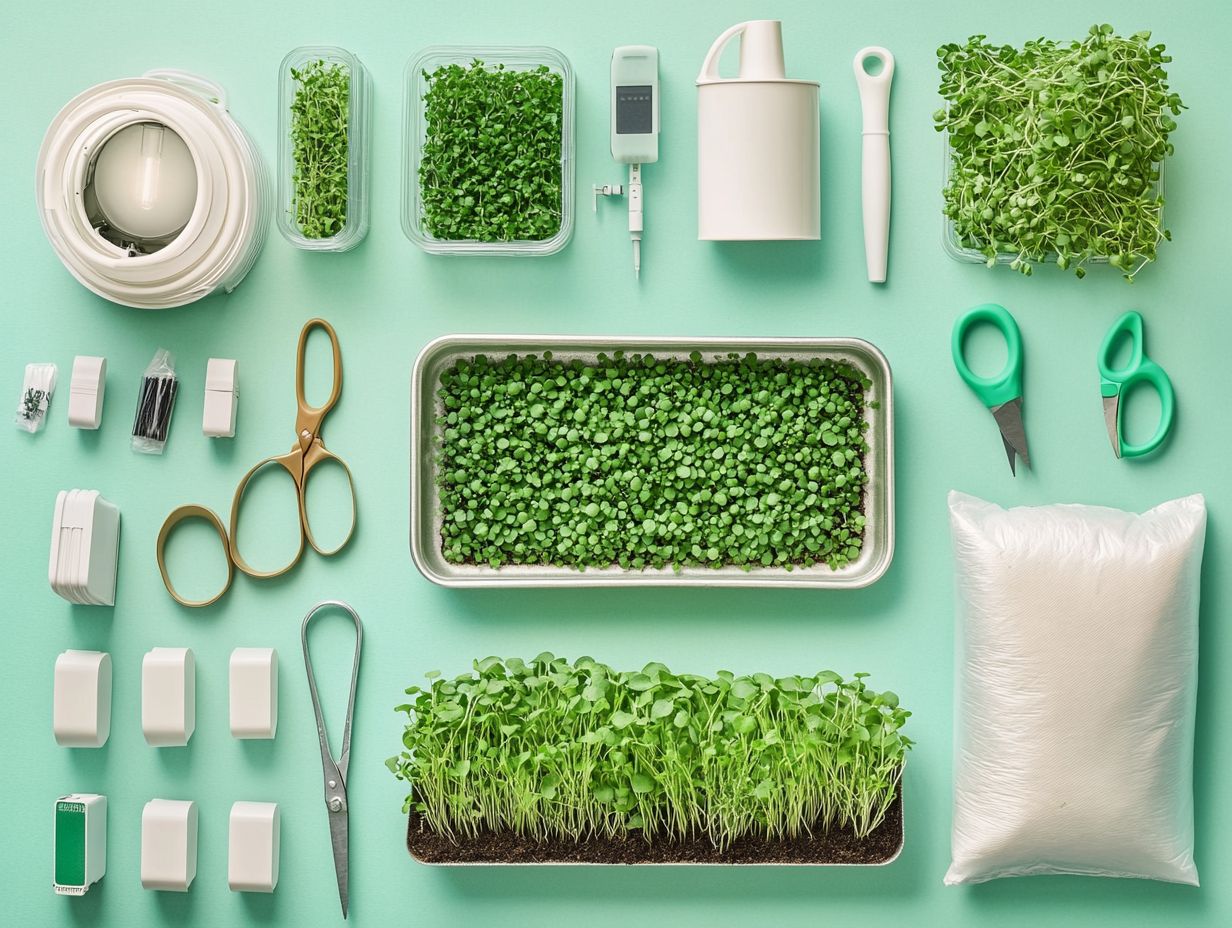
Microgreens are taking the culinary world by storm, exciting health-conscious eaters everywhere! They have found their way onto menus and into grocery stores around the world. These tiny greens not only enhance the visual appeal of dishes with their vibrant colors but also offer a remarkable array of health benefits that align perfectly with the growing trend of healthy living.
As you seek sustainable and nutritious food options, this burgeoning trend places microgreens firmly in the culinary spotlight, making them a staple in various dining experiences. Their straightforward growth process allows them to thrive even in limited spaces, appealing to both seasoned chefs and home gardeners eager to elevate their meals.
Rich in vitamins, minerals, and antioxidants, these miniature powerhouses significantly bolster a balanced diet. They deliver essential nutrients in a concentrated form. The rising demand for microgreens reflects an increasing awareness of the importance of healthy eating. Grocery stores are expanding their selections, inspiring innovative approaches to incorporating these greens into everyday cooking.
Don’t miss out on the chance to grow your own microgreens! Join the trend that s revolutionizing healthy eating today!
What Are the Different Types of Growing Mediums for Microgreens?
Get ready to grow! There are several growing mediums available for microgreens, each with unique benefits and challenges that can influence your growing process.
Coco Coir comes from coconuts and is a popular choice. It retains moisture and drains well, which helps roots grow strong.
If you prefer soil-based options, organic potting mixes are an excellent choice. They offer natural nutrients and support beneficial microorganisms for healthier microgreens. However, they require more management to fend off pests and diseases.
On the flip side, hydroponics, or growing plants without soil, supplies nutrients directly to the plants. This often results in faster growth. While these systems can be more complex to set up, they typically yield impressive results.
Ultimately, choosing the right medium not only aligns with sustainable practices but can also lead to healthier microgreens, benefiting both agriculture and entrepreneurship in the microgreens market.
How Can the Size and Space of the Growing Area Affect Microgreen Production?
Let s dive into the essentials! The size and layout of your growing area can profoundly influence microgreen production, impacting everything from yield to operational efficiency.
If you’re an urban farmer, using your limited space wisely boosts productivity. A larger area provides versatility in crop rotation, enabling a diverse selection and potentially increasing profits. In contrast, smaller spaces require a strategic mindset to maximize yield per square foot.
Engaging in thorough market research can unveil consumer preferences, guiding your choices about which microgreens to cultivate and when to rotate crops. This interplay between space utilization and market demand is crucial for shaping a successful business model in urban farming.
What Are the Optimal Lighting and Temperature Conditions for Microgreens?
The right lighting and temperature are key for your microgreens’ health. They significantly influence germination rates and overall quality.
To achieve the best results, consider using grow lights to simulate natural sunlight. This ensures that your delicate plants get the adequate light they need for photosynthesis. LEDs stand out for their energy efficiency and full-spectrum capabilities.
Maintaining a stable temperature is crucial. Most microgreens thrive between 65 to 75 degrees Fahrenheit. By combining proper lighting with the right temperature, you create a nurturing environment that fosters robust growth, enhances flavor profiles, and ultimately leads to a more rewarding yield for you as a grower.
Why Is It Important to Use Quality Seeds and Nutrients for Microgreens?
Using quality seeds and nutrients is crucial. They affect how well your microgreens grow and how nutritious they are.
When you select high-quality seeds, you set the stage for vibrant, nutrient-dense microgreens that will thrive in your growth environment. These premium seeds not only boost the likelihood of healthy sprouting but also play a pivotal role in the vigor and resilience of the plants as they develop.
Paired with nutrient-rich solutions that provide essential minerals and vitamins during the growth phase, you ll enjoy a bounty of lush microgreens brimming with flavor and health benefits. This meticulous focus on seed quality and nutrient application will ensure that you achieve a robust yield, making it a key consideration for anyone eager to cultivate a flourishing microgreen garden.
How Does Proper Ventilation Affect Microgreen Growth and Quality?
Proper ventilation is essential for your microgreens. It ensures optimal humidity levels and prevents mold from taking hold.
The right airflow can significantly boost their vitality. It facilitates healthy gas exchanges, such as carbon dioxide and oxygen, which are crucial for photosynthesis.
When ventilation is adequate, it circulates fresh air and regulates moisture. This effectively lowers the risk of diseases that thrive in stagnant conditions.
Don t miss out on installing adjustable fans or utilizing passive ventilation systems to strike the perfect balance. Positioning your microgreens away from tightly sealed environments promotes better air movement, ultimately leading to stronger, healthier plants that thrive in their growing conditions.
What Are the Common Mistakes Made in Microgreen Equipment Choices?
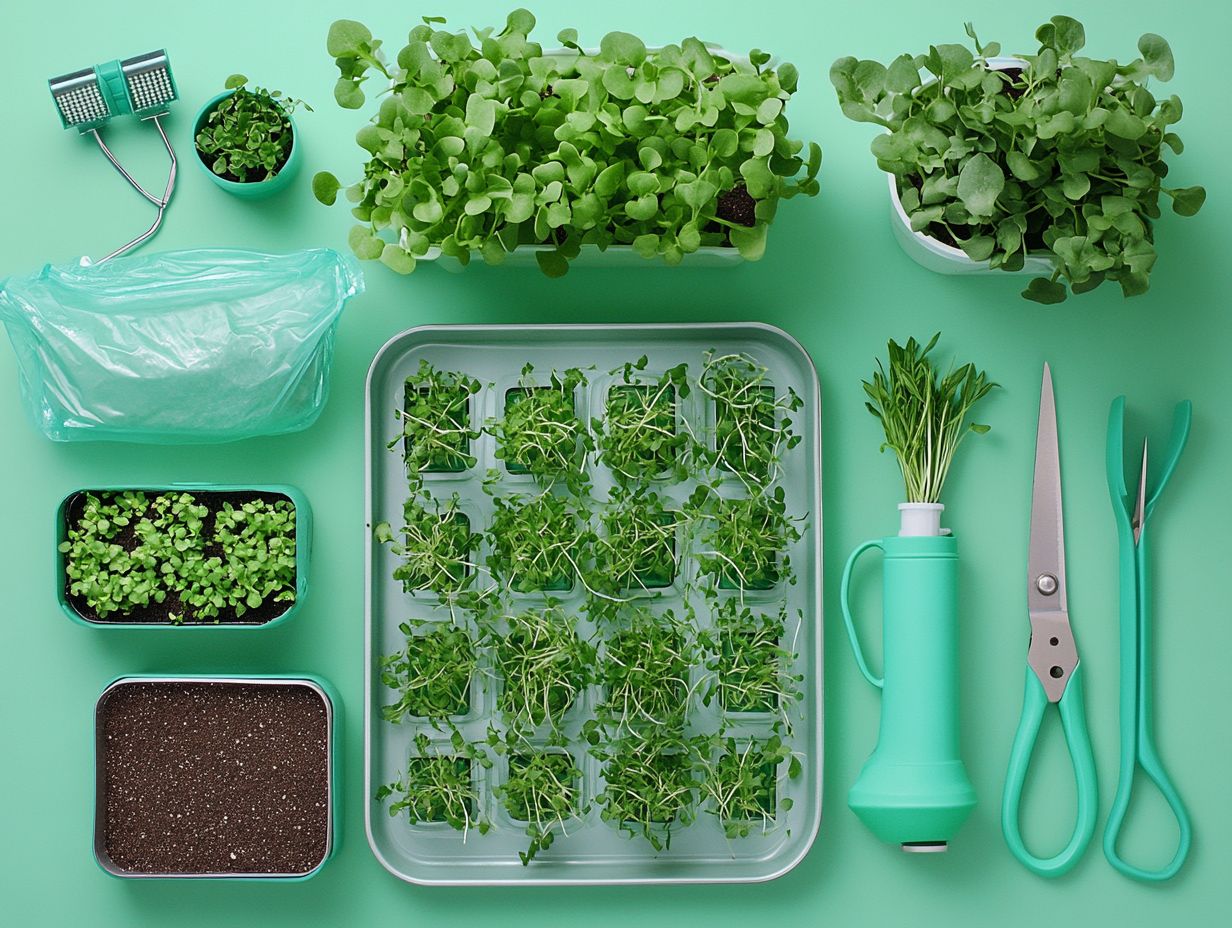
Common mistakes in your choice of microgreen equipment can lead to inefficient operations and diminished yields. This ultimately jeopardizes the viability of your business.
These pitfalls often arise from insufficient research or a lack of understanding regarding how different tools impact critical factors like soil quality and seed germination. For example, choosing the wrong type of trays or lights can stifle growth and create an unbalanced nutrient profile. To address these issues, refer to this guide on troubleshooting common microgreen growth issues, as it can help improve overall plant health.
To steer clear of these traps, take the time to consult with experienced professionals. Delve into peer reviews and conduct soil tests to ensure you’re selecting the most appropriate equipment for your specific needs. Prioritize quality over cost for long-term success, paving the way for sustainable production and profitability.
How Can These Mistakes Be Avoided or Corrected?
Avoiding or correcting common mistakes in microgreens cultivation requires a blend of expert tips, continuous learning, and attentive customer feedback.
To truly excel in this niche market, prioritize using high-quality soil mixes that encourage healthy growth. Steer clear of pesky issues like damping-off disease, which causes seeds to rot.
Staying in tune with customer preferences can help you make necessary adjustments in your growing methods or the varieties you offer. If your clients lean towards specific flavors or textures, focusing on those can lead to increased sales.
Regularly inspecting growth conditions, temperature, and humidity will enhance your yields. This also ensures your customers leave satisfied. By implementing these practices, you secure not just a bountiful harvest but also a thriving relationship with your customer base.
What Are the Benefits of Investing in the Right Microgreen Equipment?
Investing in the right microgreen equipment can significantly enhance your growth. It improves yields and streamlines your operation all while embracing the entrepreneurial spirit of sustainability.
This approach maximizes productivity and creates an environment perfect for healthy plant development. By utilizing specialized tools such as grow lights, humidity control systems, and seed trays, you can dramatically influence the quality of your microgreens.
Selecting high-quality soil and efficient nutrient delivery systems reduces the risk of disease and pests. This results in a cleaner, safer product. Over time, your investment in these resources boosts profitability and promotes healthier living by providing fresher, nutrient-dense microgreens that elevate your diet quality and overall well-being.
What are some additional tips for successful microgreen production?
Several additional tips can significantly enhance your success in growing microgreens, focusing on sustainable practices and expert insights.
By prioritizing high-quality seed selection tailored to your specific climatic conditions, you can lay a robust foundation for your microgreen efforts. Additionally, be mindful of common mistakes in growing microgreens. Cultivating a diverse variety of greens caters to a broader range of customer tastes and allows you to explore different growth patterns and harvest times.
Regularly monitoring environmental factors such as light, humidity, and temperature helps maintain optimal growth conditions. Engaging effectively with your customers through clear communication and offering educational resources fosters loyalty and enhances sales, ultimately creating a thriving microgreen business that benefits both you and the community.
What are the potential risks of not using the appropriate equipment for microgreens?
Failing to use the right equipment for microgreens can lead to serious problems, including compromised plant health, diminished yields, and potential food safety concerns.
Choosing the right tools can greatly affect your results and influence the long-term sustainability of your growing environment. For example, using improper soil composition can stifle root development, resulting in weaker plants that are more vulnerable to pests and diseases. To combat this, consider the top 5 pest control supplies for microgreens to protect your crops. Inadequate moisture control may encourage mold growth, jeopardizing both plant integrity and food safety standards.
Consequently, poor equipment decisions can create a ripple effect, undermining your aspirations of fostering healthy living and enhancing the nutritional quality of the food you produce.
Frequently Asked Questions
What are the top 5 mistakes to avoid when choosing equipment for microgreens?
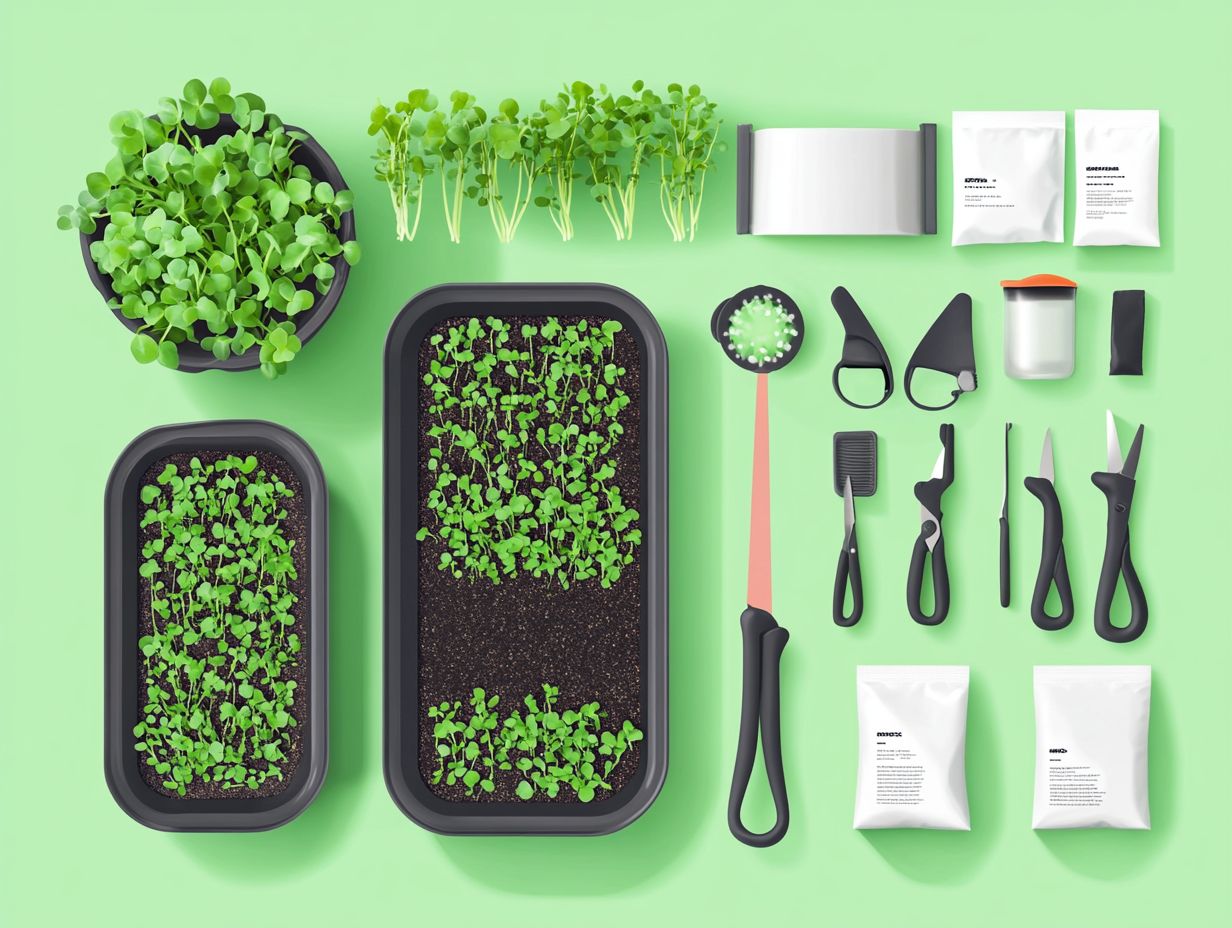
- Not considering the size and type of grow space.
- Choosing equipment that is not suitable for the specific type of microgreens.
- Not factoring in the cost and maintenance of the equipment.
- Not researching and comparing different brands and models.
- Overlooking the importance of proper ventilation and lighting.
How does the size and type of grow space affect equipment choices for microgreens?
The size and type of grow space greatly impact equipment choices for microgreens. If you have a small indoor space, you will need smaller and more compact equipment compared to a larger outdoor space. The type of grow space whether it’s a greenhouse, grow room, or vertical garden will also determine the equipment needed.
Why is it important to choose equipment suitable for the specific type of microgreens?
Each type of microgreen has its own unique growth requirements, such as lighting, temperature, and humidity levels. Choosing unsuitable equipment can hinder their growth and affect the quality and yield of your harvest. You must research and select equipment that provides the necessary conditions for the specific microgreens you’re growing.
What should be taken into consideration when it comes to the cost and maintenance of equipment for growing microgreens?
When choosing equipment for microgreens, consider both the initial purchase cost and ongoing maintenance expenses. Some equipment may be cheaper initially but require frequent repairs or replacement parts, which can add up over time. It’s crucial to weigh the cost against the quality and durability of the equipment.
Why is it important to research and compare different brands and models of equipment for healthy living with microgreens?
Not all brands and models of equipment are created equal. Researching and comparing different options before purchasing is essential. Factors to consider include the brand’s reputation, customer reviews, equipment features, and the warranty and customer support offered. This helps ensure you are getting the best equipment for your specific needs.
Start your microgreen journey today!
How does proper ventilation and lighting play a role in choosing equipment for indoor gardening with microgreens?
Proper ventilation and lighting are vital for growing microgreens successfully. Consider how your equipment will impact these factors.
Good ventilation helps prevent mold and mildew. The right lighting affects both growth and quality. Choose equipment that meets these needs for your microgreen setup. Don’t underestimate the power of good ventilation and lighting! They are key to thriving microgreens.

